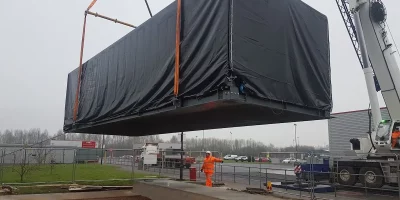Blade and rack servers are two distinct server types commonly deployed in enterprise environments, each ideal for specific scenarios and varying data requirements. Depending on your setup, different servers may offer advantages in areas such as density, power consumption, network storage, and cable management.
Blade servers and rack server designs differ from traditional servers and tower servers, which are large and stand-alone like tower PCs. Instead, servers are usually necessary for managing extensive network connections and are classified based on their structure.
What is a Blade Server?
Blade servers are designed to be modular, so they can fit more servers into a smaller space and allow for scalability. They are thinner than other servers and often come with integrated CPUs, network controllers, memory, and occasionally storage drives. The server chassis is responsible for managing multiple blade servers simultaneously. It is mounted in a server rack and provides power while facilitating components like integrated network controllers like video cards. The chassis also has designated areas for blade servers to slide into.
With this design, blade servers can function with better efficiency and fewer internal parts. You can cluster the blade server vs. other servers or use them separately per your requirements. Blade servers have multiple advantages, such as providing high availability and allowing maintenance or upgrades without taking the server offline. However, it should be noted that to scale to high processor densities, additional support is required to manage the thermal and electrical loads that come with it.
Blade servers are an infrastructure that combines multiple resources such as power supply, networking card, RAID card, cabling, etc. Unlike standard rack servers, where each server has its resources, blade servers share them, making it a more straightforward solution.
For example, suppose you have a total of 8 servers. To ensure redundancy with less risk of failure, connecting the same first commercial blade server chassis only twice instead of 8 networking connections is recommended. By reducing the points of failure, you can save your DevOps team’s time spent on replacing faulty components.
What is a Rack Server?
“Blade servers vs. servers operate together in a chassis, while rack servers function separately. Rack servers, also known as rack-mounted servers, are versatile and can support various environments. They are secured in the rack using screws or rails. Blade servers are smaller than rack servers and cannot be stacked. Due to their smaller size, they need more space for components like memory and CPUs. On the other hand, Rack servers are more significant and can include more features, making them a more comprehensive option. In addition, by stacking them within the rack, space can be saved.
Rack servers are best suited for environments requiring only a few servers due to their size and cable management needs. Unlike the blade server technology with servers that connect to a chassis for better cable management, each rack server has its cables. As a result, rack servers are commonly found in smaller businesses.
Rack servers are typically located in data centres and server closets enclosed in tall metal cages, usually measuring 7 to 9 feet. They can stack on top of one another and fit inside a rack due to their smaller size than regular tower servers or servers. However, when placed together, there is a problem with the heat generated by multiple machines. Therefore, sufficient cooling and humidity monitoring is necessary for the server closet or data centre to prevent damage to static electricity and overheating equipment.
Difference between Rack Servers and Blade Servers
Blade Server
What are the features of Blade Server?
- The large chassis can provide power to multiple servers by using blade servers, reducing overall power consumption for each blade server.
- Blade servers have hot-swappable features that allow you to replace a problematic blade for better redundancy easily.
- Blade servers use a single cable, typically fiber, that runs to the chassis instead of multiple individual wires for each blade chassis server, reducing cable use.
- Blade servers offer high processing power while taking up minimal space.
What are the pros of Blade Server?
Blade servers have certain advantages, such as:
Power management: The chassis can effectively provide power to multiple servers, lowering overall power consumption.
Cable management: Running only one cable to the chassis simplifies cable management and prevents safety issues caused by tangled wires.
Hot-swappable: Blade servers can be configured to allow for hot-swapping, which means they can be easily removed storage area network and replaced individually without taking the entire system offline. This setup supports maintenance and repair of the servers, as well as redundancy.
High processing power: The servers have a compact design but can still deliver high computing power.
Versatility: Blade servers can be used for multiple purposes, such as hosting operating systems, databases, software, web services network attached storage, applications, etc.
High availability: Blade servers provide high availability through centralised management, hot-swapping, load balancing, and clustered failover.
What are the cons of Blade Server?
Blade servers have potential disadvantages, which are:
Higher upfront costs: Blade servers tend to have higher costs at the beginning due to deployment and configuration than rack servers. Although there might be lower ongoing costs due to simplified maintenance and power consumption, the initial costs can still demand significant capital. In addition, although the whole server blades are cheaper than individual rack servers, the cost increases when the chassis is filled with blades.
Higher cooling costs: Blade servers typically require more effective climate control mechanisms due to their high densities. The energy demands of these can contribute more to the price than the cooling requirements of rack servers.
Less onboard storage: Blade servers usually have less built-in storage capacity than rack servers due to their smaller size. To meet future requirements, they may require connection to external storage solutions such as SANs.
Rack Server
What are the features of Rack Server?
• A rack server system is a powerful system that operates alone and contains all the necessary components. It is capable of running high-end applications.
• Rack servers are convenient because they take up less physical space.
• Rack servers typically have internal fans that increase airflows, facilitating cooling.
• If you need more than one server room, rack servers are a highly efficient option because they don’t require a large chassis.
What are the pros of Rack Server?
Rack servers offer several benefits, such as:
Performance: Rack servers are capable of handling high-end applications.
Compact size: Although blade servers are smaller than rack servers, traditional tower-style server servers can be challenging due to their larger size. In contrast, rack servers are more manageable since they are mounted within the rack and are more compact.
Easier cooling: Rack servers are usually easier to cool because they have fewer internal components and fans built-in, and the rack-style design allows for increased airflow.
Lower costs: The rack-mounted option is typically more cost-effective when you require only a few servers.
What are the cons of Rack Server?
Rack servers have some possible disadvantages, such as:
Cooling requirements: Rack servers still rely on a powerful cooling system despite being easier to cool. This could result in increased energy costs.
Less efficiency: Rack servers are generally less energy-efficient compared to more efficient blade servers.
Increased maintenance: Managing and troubleshooting servers in dense racks requires more maintenance resources. The larger frames and improved cable management demands, unlike rack servers, can also contribute to longer work times with rack servers.
Bottom Line
It is difficult to determine the best server between the Blade server system and Rack server since both have the same functionalities and work similarly, as discussed above. To choose between the two options, consider your processing requirements, physical space layout, and your machine’s power and computing needs, such as thermal and electrical power requirements.
The choice between using a rack or blade server depends on the situation. While both types of servers can perform the same tasks, it’s essential to consider the most cost-effective option. To find the best commercial blade server for your needs, consider the processing requirements, space layout, thermal and electrical needs of the machine (plate rating), computer requirements (CPU/hr.), and facility capacity (Watts/sq. ft.).






